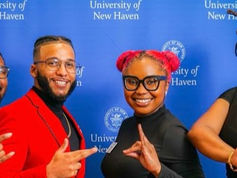The Media Won't Wait For Literacy
- Abigail Riggins

- Feb 6
- 4 min read
While this is my crude interpretation, almost everyone has seen the meme, which makes fun of the seemingly overinterpretation of minor details in literature.

While we may have rolled our eyes listening to our English teachers discuss what the color green represents in The Great Gatsby, these classes teach us fundamental media comprehension skills.
When the world was forced into lockdown in 2019 due to the pandemic, it created a massive setback for the comprehension skills of young children.
Students had to adapt to online and asynchronous learning, which had disastrous consequences for young children's development. A research study performed by the Library of Medicine states that 32.8% of children from grades K-8 were behind grade level in literacy and comprehension.
One of the most frustrating repercussions of the decline in literacy comprehension is the lack of media literacy.
Media literacy means the ability to interpret the deeper and more complex nuances behind media and the ability to think critically when confronted with challenging topics and discussions. Why is this the most frustrating repercussion?
Have you ever fallen in love with a character, only to go online and read egregious mischaracterizations? Have you read a critique about a movie that sounded like they watched it muted and with their eyes shut?
This is the lack of media literacy.
The popular Netflix original “Arcane” is a perfect example of a complex show that delves into complex topics. The audience struggles to fully grasp the point.
One of the most controversial characters is Caitlyn Kirramman, the daughter of nobles and a high-ranking officer in the city of Piltover, where most of the upper class lives.
One of the biggest conflicts in the show is the fight between Piltover and Zaun, described as a crime ridden undercity. Zaun, however, can be seen as a clear representation of the lower class and the struggles the poor face at the hands of the wealthy.
Piltover and Zauns’ consistent battle is a class war but the show allows you to connect with and empathize with characters of all backgrounds. You can see the horror of the enforcers from the perspective of children in Zaun. You also get to see the fear and pain of innocent Piltover citizens at the hand of attacks from angry citizen’s of Zaun.
Caitlyn can be described as a morally grey character…which is the root of the issue. Media literacy is crucial to empathizing with her struggles and not supporting her actions.
Caitlyn lost people close to her at the hands of Jinx, a Zaunite (resident of Zaun) and a wanted criminal. The grief of losing someone close is a pain that can and should be sympathized with, and important to understand why she would want justice for Jinx’s actions.
Her actions for said justice was to use her newly appointed power to use toxic industrial waste, to gas out Zaun and innocent civilians in an attempt to get to Jinx. This shift right here in Caitlyn’s character is crucial to analyze and understand, but many miss the mark.
To not understand her suffering, completely misses her humanity and vulnerability. In the wake of losing her loved ones at the hands of Jinx, Caitlyn is trapped in her grief and mourning. Her vulnerability made her susceptible to the manipulation of Ambessa, a high ranking general and matriarch of the influential Medarda family. Ambessa is ruthless and manipulative. She utilizes Caitlyn's rage, driven by grief, and appoints Caitlyn as head of Piltover’s enforcers. Caitlyn is used as a chess piece in Ambessa’s game for power and control. She was never going to be able to bring her loved ones true justice.
To overly sympathize with her, you miss the fact her character is also meant to elude the speed in which “protecting civilians” turns into brutality and dictatorship. To get back at Jinx, she harms innocent civilians in Zaun with no means to escape the toxic gas. There is also the subtlety where the symbol of Piltover on the enforcers suits and banners, changes into Caitlyn’s family crest, signifying the shift in power and control. Caitlyn’s determination to avenge her loved ones and protect her citizens, leads to abuse of power and police brutality.
Caitlyn is a character doomed to fail no matter the efforts she makes. No matter what, she is in a predicament where in her position of power she will, no matter what, hurt innocent civilians and the people close to her. Justice was never a real option.
Her character is so rich with nuance that fans mischaracterize her, unable to comprehend her as a whole. I would describe her as one of the best antiheroes in the media.
It is more common than not in the media that antiheroes and villains are mischaracterized, and fans miss the mark completely when analyzing their motives and actions. However, social media has taken to aiding the process of deconstructing characters and teaching media literacy to those who watch.
A perfect example of utilizing and strengthening other’s media literacy is Tiktoker @luckyleftie.
This page is dedicated to analyzing and critiquing different forms of media, and encourages followers to practice deeper levels of thinking about the entertainment we consume.
If we don’t make the conscious decision to practice these lost skills, we will miss out on enriching media and strengthening our critical-thinking. Our media will not wait for us to learn literacy.














Comments